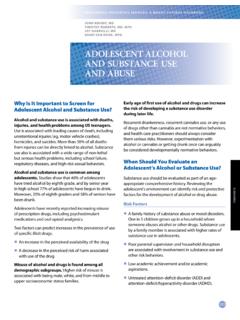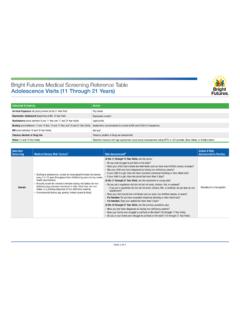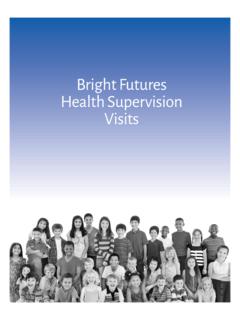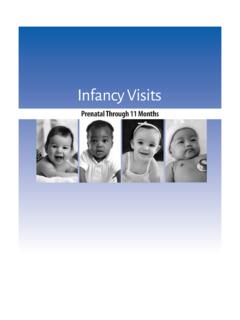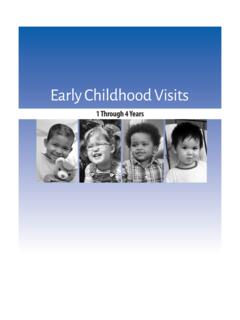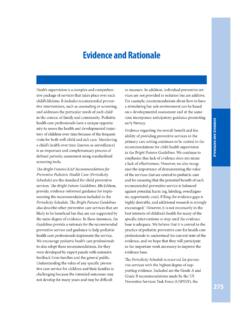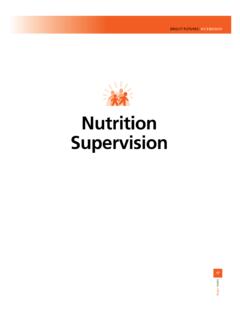Transcription of Promoting Mental Health - Bright Futures
1 Promoting Mental Health Promoting Mental Health . Establishing Mental Health and emotional well- care professional, therefore, is challenged to being is arguably a core task for developing chil- promote Mental Health through activities that dren and adolescents and those who care for them. are aimed at prevention, risk assessment, and Mental Health is not merely the absence of Mental diagnosis and to offer an array of appropriate disorder but is composed of social, emotional, and interventions. Common risk factors for child behavioral Health and wellness and should be con- behavioral and Mental Health problems include2-4. sidered in the same context as physical Health . Prenatal risk factors Because cultures may differ in their conceptions Developmental trauma of Mental Health , it is important for the Health care professional to learn about family members' percep- Alcohol exposure tions of a mentally healthy individual and their goals Drug exposure for raising children.
2 In their shared work to raise a Lead exposure child, parents, family, community, and professionals Environmental toxins commit to fostering the development of that child's Genetic risk factors (eg, congenital sense of connectedness, self-worth and joyfulness, developmental disability). intellectual growth, and Mental Health . Shonkoff Chronic medical illness or developmental and Phillips1 describe that marvelous process of disability the child's development of Mental Health in their Social and environmental risk factors book From Neurons to Neighborhoods. Each Bright Poverty or homelessness Futures Health Supervision Visit addresses the phy- Exposure to intimate partner violence (IPV).
3 Sical and Mental Health of the child or adolescent. or child maltreatment This theme highlights opportunities for Promoting Foster care placement Mental Health in every child, including specific Disasters or other life trauma suggestions for each age and stage Family risk factors of development. Parental depression and social isolation Mental Health can be compromised Bereavement at many critical times in develop- Separation or divorce ment, beginning Chronic physical illness or Mental disorder prenatally with or death involving family members the Mental Substance misuse by a family member Health of the Incarceration of a family member mother, through Military service of a family member infancy with Skills deficiencies the importance Lack of parenting knowledge or performance of attachments, deficits through early Child social skills deficits childhood, and School failure and learning problem beyond.
4 The Health or disability 115. BFG 4TH 115 1/20/17 2:46 PM. Bright Futures Guidelines for Health Supervision of Infants, Children, and Adolescents Common challenges to child, adolescent, and and substance use Among vulnerable family Mental Health are further described in this populations of youth, such as those involved in the Promoting Mental Health . theme by age of highest prevalence. (For additional juvenile justice system, high rates of psychiatric discussions on these issues, see the Promoting Lifelong disorders (66% of boys and 74% of girls) Health for Families and Communities theme.) Unfortunately, under-detection of Mental Health In 2004, the American Academy of Pediatrics problems in pediatric practice has been well- (AAP) convened a Task Force on Mental Health documented and recognized,11,12 and even among to help Health care professionals enhance the youth who have been identified, many do not seek, Mental Health care they The goals of this find, or receive treatment ,14.
5 Task force were to build Health care professional skills and enhance services through systems change Screening and Referral in clinical practice and in the family's community of Primary care professionals meet with children and care. The task force developed a report for Health families at regular intervals, and this frequent access care professionals, which includes 2 algorithms to a primary care medical home is more available for care, and a companion The algorithms than access to specific Mental Health services. are (1) Promoting Social-Emotional Health , Iden- Primary care professionals are therefore ideally tifying Mental Health and Substance Use Concerns, situated to begin the process of identifying children Engaging the Family, and Providing Early Inter- with problem behaviors that might indicate Mental vention in Primary Care and (2) Assessment and disorders, as well as identifying parents and care- Care of Children With Identified Social-Emotional, givers struggling with Mental Health concerns Mental Health , or Substance Abuse Concerns, that may affect the child.
6 Consistent with the US. Ages 0 to 21 Years. The AAP has compiled a Preventive Services Task Force (USPSTF) recom- collection of Mental Health competencies and mendation, screening for depression among encourages Health care professionals to integrate adolescents in primary care is now included in the Mental Health into primary care and specialty Bright Futures : Guidelines for Health Supervision care of Infants, Children, and Adolescents Adolescence Building a solid collaboration among the Prevalence and Trends in Mental Health care professional and other service providers Health Problems Among Children (eg, psychiatrists, psychologists, social workers, and Adolescents and other therapists) and agencies (eg, schools, Mental Health agencies, state departments of Health , One-half of all the lifetime cases of Mental disorder mentoring groups, agencies serving children and begin by age 14 years, and three-quarters are youth with special Health care needs, and child apparent by age Therefore, most Mental Health protective services)
7 Improves the effectiveness of problems are chronic, with roots of origin during support for children and, ultimately, the possibili- youth. For example, the median age of onset for ties of positive outcomes for the children. (For more anxiety and impulse control disorders is about age information on this topic, see the Promoting Lifelong One in 5 teens experiences significant symp- Health for Families and Communities theme.) This toms of emotional distress, and nearly 1 in 10 is need is illustrated by a study showing that although emotionally impaired, with the most common psychosocial problems identified in pediatric offices disorders including depression, anxiety disorders, increased from to in the 17-year period attention-deficit/hyperactivity disorder (ADHD), of 1979 1996,16 the National Institute for Health 116.
8 BFG 4TH 116 1/20/17 2:46 PM. Bright Futures Guidelines for Health Supervision of Infants, Children, and Adolescents Care Management estimates that 75% of children and adolescents is by using a Mental Health screen- diagnosed as having Mental disorders are treated ing test, such as the 35-item Pediatric Symptom Promoting Mental Health . by primary care These professionals Checklist (PSC)23 or the more brief PSC-17,24. often have limited access to Mental Health profes- which can be completed in the waiting room by sionals with appropriate training and skills to a parent. A positive score on the PSC suggests assist them with behavior screening, treatment, the need for further evaluation. The Survey of Well- and referral Collaborative or integrated being of Young Children (known as SWYC) screens Mental Health care in pediatric practice offers child development from birth to age 5 by assessing improved access to Mental Health care and 3 domains of psychosocial Health : the develop- improved Mental domain, the social and emotional domain, Pediatric behavioral, developmental, and Mental and the family The Patient Health Health issues are more common than childhood Questionnaire-2 (PHQ-2) has been successfully cancers, cardiac problems, and renal problems used to screen for adolescent depression in clinical combined.
9 However, research has repeatedly settings with adequate sensitivity and shown that primary care professionals recognize All of these tools are available in the public domain. less than 30% of children with substantial dysfunc- All tools should be administered in the family's This lack of recognition is caused by the primary language. necessary brevity of pediatric appointments and Screening does not provide a diagnosis for a Mental stigma associated with Mental Health concerns, disorder, however. Screening indicates the severity which result in hesitancy to bring up subject areas of symptoms, assesses the severity within a given for which no quick fix exists. However, in some time period, and provides a way to begin a con- cases, the primary care professional can assess versation about Mental Health issues.
10 Health care the child's problem and provide appropriate and professionals must be adept at identifying Mental successful intervention. The Health care profes- Health concerns and determining whether they sional should try to determine whether the nature are leading to impaired functioning at home, at of the problem falls within her areas of interest and school, with peers, or in the community. Providing expertise before offering interventions. In other education to the patient and parent about Mental instances, when a problem is identified outside the disorders, symptoms, causes, and treatments is realm of her expertise, the Health care professional an important first step in helping the family take must be able to refer the family to experts who can charge of its management if a disorder exists.



